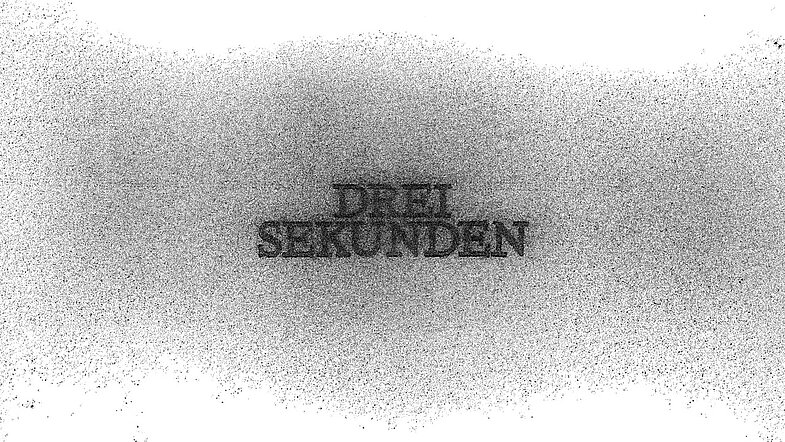
"Everything that is takes three seconds
One second for before, one for after, one for in the middle
For where the glacier calves, where the seconds fly into the blue sea."
- Peter Licht, sun deck (Sonnendeck)
Everything we call the world — everything we grasp, feel and think — lives in a narrow slit of time: three seconds. Then the moment flies away, loses its sharpness and becomes a memory or an absence.
What we perceive as “now” is not stable. Neuroscience has shown that our conscious presence occurs in three-second bursts of experience. After that, a new time stream begins — a new “now” that swallows up the previous one. During these two-second windows, our brain stores information such as the sound of a melody, the gesture of another person or the movement of our own body. Once the stimulus has ended, the sorting begins — and so does the forgetting.
The artists in this exhibition explore the space between what was and what is no longer. Their works celebrate the ephemeral in-between, where an image disintegrates, a form flees and a thought dissolves.
DREI SEKUNDEN is an attempt to make the absent visible. The exhibition creates spaces for the ephemeral and opens up resonant spaces for the present moment, which slips away from us as soon as we grasp it. Here, absence is not viewed as loss, but as a prerequisite for perceiving presence. After all, only that which passes can have been present.


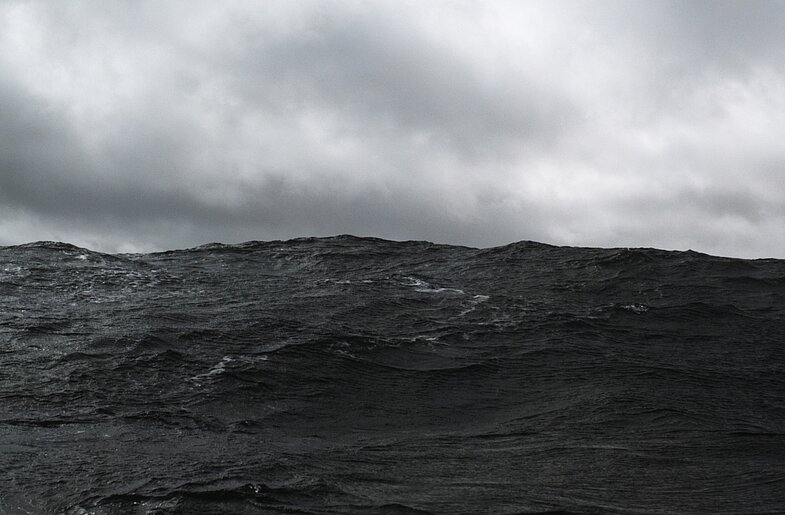
Born in 1983 and living in Berlin, Julius von Bismarck explores human perception in his works, using the laws of physics to question our viewing habits.
In his video work You have to think the sky away (Den Himmel muss man sich wegdenken) (2014), presented as part of the exhibition DREI SEKUNDEN, he explores this concept further. The film documents the movement of a huge wave during a storm, revealing a monochrome landscape beneath a strip of sky. Barely perceptible at first, a subtle movement can be seen in the waves' pointed contours — an organic contraction and expansion of a mountain. This mass of water flows through the image with the coagulated weight and force of lava. The film was shot with a high-speed camera, enabling Julius von Bismarck to capture and slow down the fleeting movement of a giant wave.
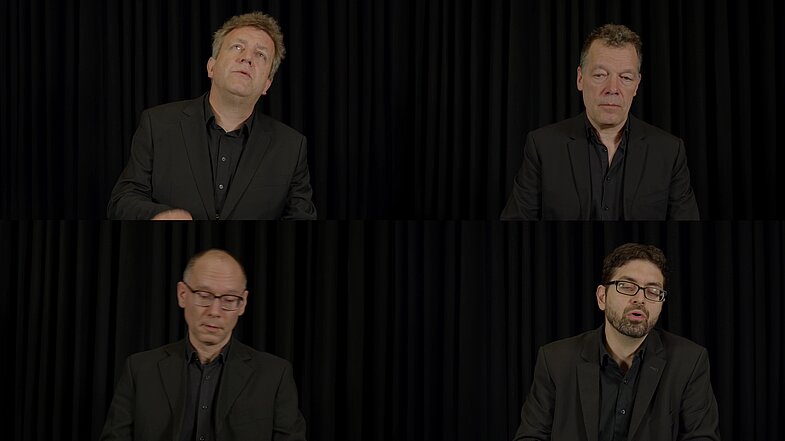
William Engelen (born 1964, lives in Berlin) is a visual artist and composer. His work operates at the intersection of visual art and music. Through the interplay of these two disciplines, he explores the boundaries between image and sound, developing hybrid forms such as installations, performances, videos, scores, and models.
His video work, À la Gould, is dedicated to the legendary pianist Glenn Gould, focusing not on his playing, but on what Gould himself found disturbing: his humming, breathing and the rustling of his clothes. Four pianists each interpret a variation from Bach's Goldberg Variations — albeit silently; they play on an invisible textile piano and only their background noises and physical presence can be heard.
Edited by Dagmara Genda, the video work shows four variations (Aria and Nos. 12, 15 and 20), each arranged differently. The focus is on the diversity of interpretation, sense of time, and physical expression. Although the musicians were recorded individually, their contributions were combined to create polyphonic, quasi-improvised “ensembles” — a tribute to the complexity of musical performance.
Engelen thus turns Glenn Gould's quest for the perfect studio recording into a poetic meditation on variation, repetition, and impermanence. In the absence of the instrument, he creates music where there seems to be none — in the in-between.
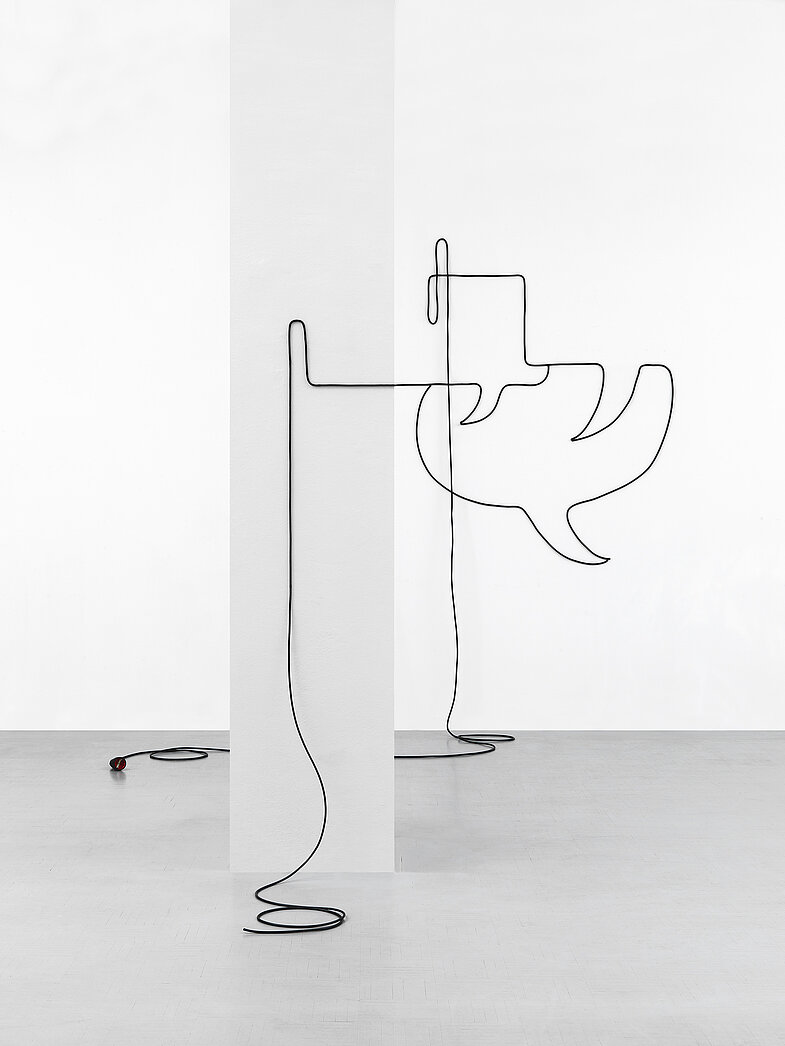
Igor Eškinja (born 1975, lives in Rijeka, Croatia) creates spatial works that challenge perception with modesty and elegance. His installations and wall drawings are created from simple materials, such as adhesive tape and electrical cables, which he arranges with the utmost precision within strictly calculated spatial structures. In this way, he creates pieces that oscillate between two and three dimensions, penetrating beyond the visible into imaginary and immaterial spaces.
Reducing form opens up a multi-layered spectrum of meaning: emptiness becomes an active space of perception and a projection surface for the imagination. Rather than using this emptiness for concealment, Eškinja uses it as a commentary on the regime of visibility, inviting the viewer to create an imaginary volume with their gaze.
The transient nature of his works, such as ornamental carpets made of dust or ash, also symbolises a quiet resistance to institutional and social conventions. Eškinja’s art consciously confronts the ephemerality and openness of space.
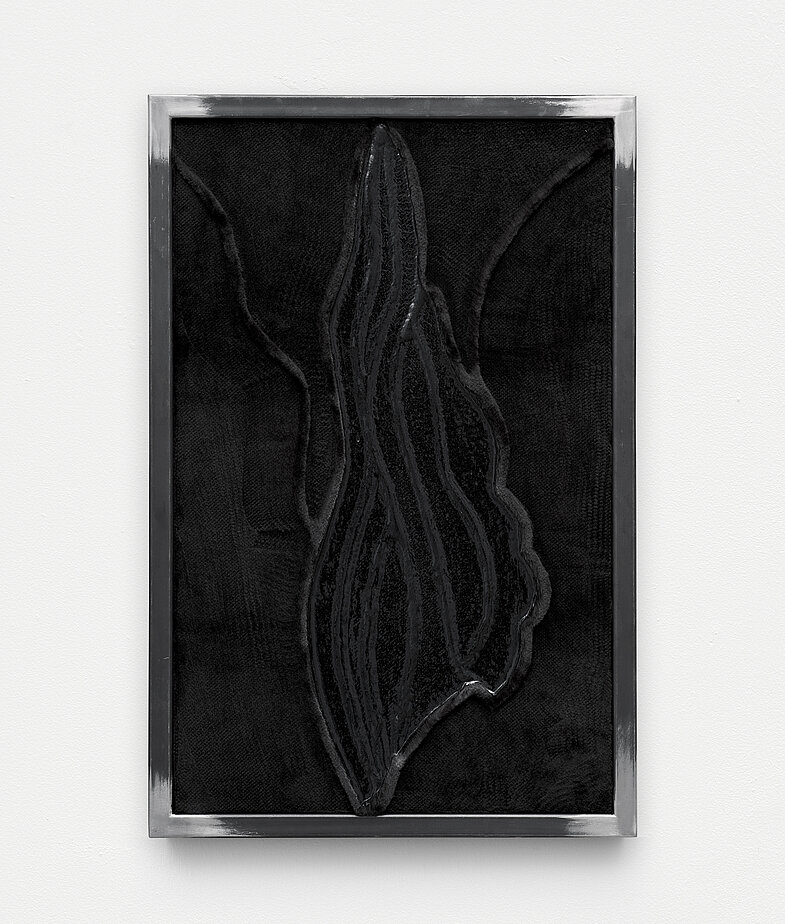
Sabrina Fritsch (born 1979, lives in Cologne) has been Professor of Painting at the Kunstakademie Düsseldorf since 2021. Her works are characterised by a precise examination of surface, structure, and materiality. In her multi-layered compositions, she creates an original, poetic style of painting that combines sensual perception and conceptual rigour.
For DREI SEKUNDEN, Fritsch developed an expansive installation based on the principle of an oversized type case — a historical organisational aid from the printing press traditionally used for storing letters. This structure, which symbolises language, order and systematics, remains largely empty. Only individual segments feature black, finely modulated paintings that reveal shadowy silhouettes of women's bodies in subtle lighting. However, rather than being hung in the compartments, the works detach themselves from their fixed boundaries. Instead, they use the framework of the compartments as an open display, emancipating themselves from strict order in favour of poetic openness. The deliberate emptiness between the filled areas reinforces the effect of absence, referring to the invisible, hidden or forgotten. Fritsch's work thus oscillates between presence and absence, systematisation and dissolution.
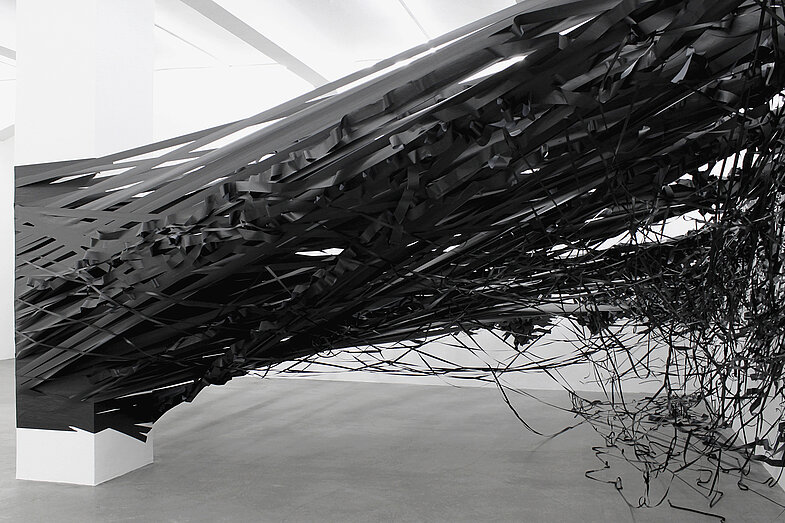
Monika Grzymala (born 1970, lives in Berlin) is a contemporary illustrator, sculptor and installation artist who specialises in architectural intervention and spatial drawing.
As a sculptor who draws, Grzymala works with a variety of media, locating these as ephemeral or permanent interventions in space. For her large-format works, she uses materials ranging from adhesive tape to 3D drawing in VR.
For DREI SEKUNDEN, she realises a large-scale tape installation whose lines form a dynamic network in space. The empty spaces in between are just as important as the visible connections. Over the course of the exhibition, the work begins to disintegrate — a planned process that addresses transience, emptiness, and transformation.
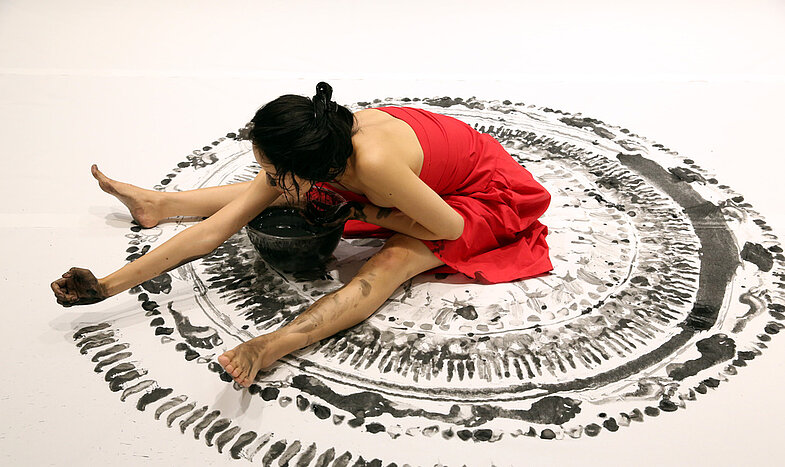
Moonjoo Kim (born 1998 in Seoul; lives and works in Essen) is a dancer and performer whose work is characterised by a deep sensitivity to movement, body awareness, and subtle gestures. Drawing on traditional Korean dance, she combines physical forms of expression with visual and structural elements. She focuses on exploring movement within the tension between dance, drawing and notation. In her work, physical precision, poetic imagination and analytical clarity converge to create an original performative language.
Her performances often unfold at the intersection of body, line and space. Moonjoo Kim is interested in the traces that movement leaves behind, whether in bodily memory, on the surface, or in collective experience. To this end, she draws on and expands choreographic and notational practices to include personal, culturally influenced perspectives.
For DREI SEKUNDEN, she presents 몸프린트 (Body print), a long duration performance in which her body becomes a drawing tool. Through repetitive motion, ink, and physical contact, she creates traces of time, effort, and presence. The work resists speed and finality, instead foregrounding slow accumulation, persistence, and the tension between control and release.
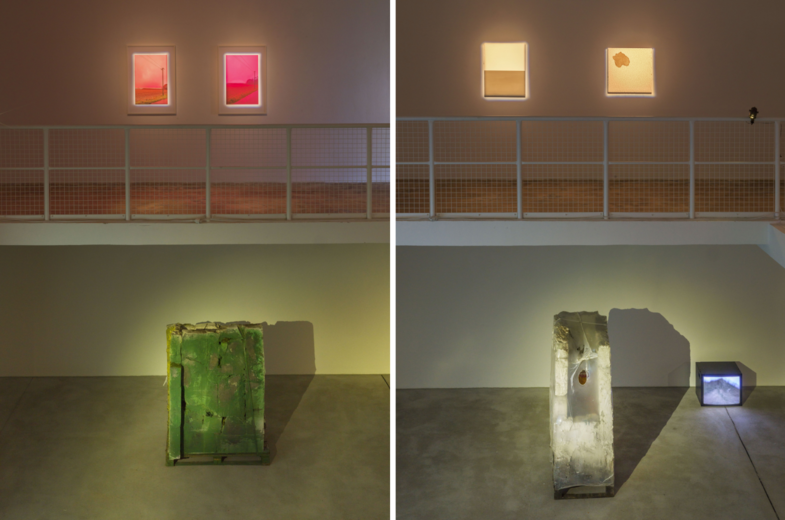
Gregor Schneider (born 1969, lives in Rheydt) explores existential themes concerning the presence and absence of people in space and the intangible. His art reveals the hidden, capturing that which cannot be expressed in words, but rather communicated through atmosphere.
In VITAROM, Schneider turns his attention to the altered landscapes of his native Rhineland. The photographs depict deserted locations in Neurath that have undergone technological transformation. The artificial light is particularly striking: a violet-pink glow emanating from neighbouring greenhouses. This light serves to optimise plant growth and completely colours the sky on foggy days. Like an atmospheric filter, this light both distorts and redefines reality.
This colour is not digitally added — it is real. Anyone driving past on the motorway might think that the neighbouring power stations are on fire. This visual effect is as spectacular as it is disturbing, marking a future in which the landscape becomes a surface superimposed with technological interventions and decoupled from the natural order.
The photographs point to a future in which the landscape is mechanised, emptied, and visually transformed. VITAROM renders visible what is disappearing and demonstrates how the invisible shapes our reality.
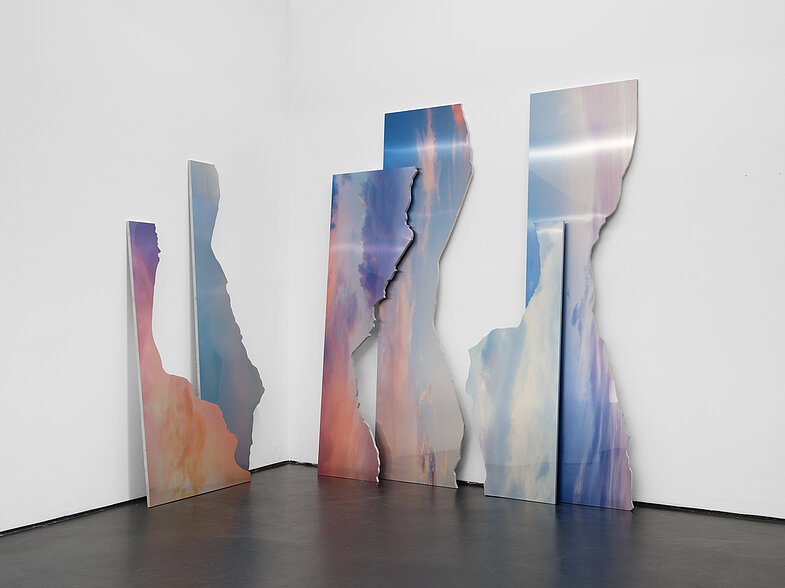
Troika is an art collective founded in 2003 by Eva Rucki (b. 1976, Germany), Conny Freyer (b. 1976, Germany) and Sébastien Noel (b. 1977, France). The artists live and work in London, UK. In their paintings, sculptures, films and expansive installations, they explore the relationship between analogue and digital realities.
Troika presents Obsolete Landscapes (2024), a series of works exploring digital representation and the disappearance of natural landscapes. Since 2014, the collective has edited iconic desktop backgrounds from Apple operating systems, showing Californian landscapes so that only the sky is visible. By removing landscape elements, Troika questions the aestheticisation and trivialisation of these natural beauties in the digital world. The series addresses technological progress and its contribution to the erosion of these landscapes, both through the extraction of resources for product manufacturing and through the obsolescence of digital representations with each new update. These pieces encourage us to consider our relationship with nature as a disposable resource, and to recognise the role of the sky as a unifying element beyond the reach of capitalist exploitation.
2 August - 14 September 2025
Preview / Curator's tour
Friday, 1 August, 5.30 pm
Opening
Friday, 1 August, 7 pm
Performance
Moonjoo Kim 몸프린트 (Body Print)
Friday, 1 August, 7.30 - 10 pm
Artists:
Julius von Bismarck
William Engelen
Igor Eškinja
Sabrina Fritsch
Monika Grzymala
Moonjoo Kim
Gregor Schneider
Troika
Performance
Friday, 1 August, 7.30 - 10 pm
Moonjoo Kim 몸프린트 (Body Print)
Curators:
Dr. Pia Wojtys, Anna-Maria Bogner
Curator tours
Saturday, 30 August, 3 pm and 4 pm
Finissage
Curator tour & catalog presentation
Sunday, 14 September, 4.30 pm
Title graphic: Viola Dessin, Jonas Brüggemann
Images works: © the artists
Images opening: © JS/Künstlerhaus Dortmund
Kindly supported by:
Kulturbüro Dortmund, Bergmann Bier, StadtbezirksMarketing Dortmund e.V., Kulturrucksack NRW
Das Geheimnis der unsichtbaren Dinge
Photo workshop for kids and teens
18 - 21 August, 11 am - 3 pm